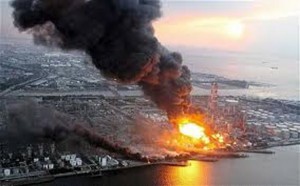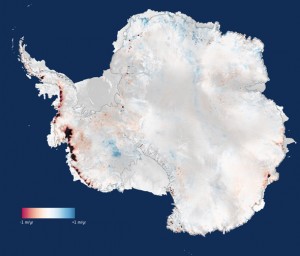A lot of people have been talking about a new dawn of nuclear power (Telegraph, article from 2013 here). “Fukushima,” they say, perversely, “proves nuclear is safe because only 3 reactors melted down.” They also say, “a culture of safety can make or break nuclear power.” (Japan Times, op-ed, here).
I think these people are not asking the right questions.
For example, the melt-rate of Antarctic ice has double since before 2010, that is since before Fukushima. Andrew Freedman on Mashable, here, and Phil Plait, on Slate, here wrote about a scientific study, accepted for publication in the journal Geophysical Research Letters which documents the increase in the rate at which Antarctic ice is melting. The study attributes this increased ice-melt-rate to rising ocean temperatures. The conventional wisdom is that “The increase in atmospheric carbon dioxide is causing ocean temperatures to rise.” But … what if this is only part of the problem?
What effect, if any, does the release of radiation from the Fukushima melt-down have on ocean temperature and therefore, the rate of melting ice?
Given that radioactive particles are hot, and the amount of radioactive material in the Pacific due to the melt-down, the answer may be “Trivial” but it can’t be “Zero.”
Suppose you have a bathtub with 50 liters of water at 40 C. If you add another 50 L of water, at 60 C, you now have a bathtub with 100 L of water at 50 C. If you have an ocean with 714 million cubic kilometers of water, and you add a quantity of radioactive material emitting radioactive particles …
Freedman notes,
“The new research, by a team of researchers in the U.K., used observations from the CryoSat-2 satellite to produce the first estimate of the volume and mass change of nearly the entire Antarctic ice sheet. The data used in the study included more than 455,000 independent estimates of changes in the land elevation of the vast ice sheets covering Antarctica, both in the western part of the continent, where ice is melting more rapidly, and in the east, where the ice is considered to be more stable, for the time being at least.”
Not surprisingly, the area of more rapid ice melt is on the Pacific, North-East of the Ross Sea, approaching South America.
This may be circumstantial evidence. But it seems to me that the question is not “Is radiation from Fukushima raising the temperature of the Pacific and increasing the rate at which Antarctic ice is melting?” The question is “How much?”
–
Larry Furman co-founded Popular Logistics with Jon Soroko in 2007. Larry holds a BS in Biology and Computer Science and an MBA in Managing for Sustainability. He has been thinking about energy, utility economics, offshore wind and nuclear power since his work as an energy intern with NYPIRG in 1976. Available for consulting, Larry can be reached at “L Furman . MBA” at G Mail.


